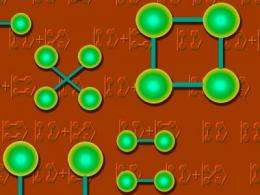Quantum simulation with light: Frustrations between photon pairs

Researchers of the University of Vienna used a quantum mechanical system in the laboratory to simulate complex many-body systems. This experiment promises future quantum simulators enormous potential insights into unknown quantum phenomena.
Researchers from the Vienna Center for Quantum Science and Technology at the University of Vienna and the Institute of Quantum Optics and Quantum Information at the Austrian Academy of Sciences used a quantum mechanical system in the laboratory to simulate complex many-body systems. This experiment, which is published in Nature Physics, promises future quantum simulators enormous potential insights into unknown quantum phenomena.
Already the behavior of relatively small quantum systems cannot be calculated because quantum states contain much more information than their classical counter-parts. However, if another quantum system is used to simulate the quantum system of interest, then answers about the properties of the complex quantum system can be obtained.
When is a quantum system frustrated?
Currently, many international groups are focusing their research on frustrated quantum systems, which have been conjectured to explain high-temperature superconductivity. A quantum system is frustrated if competing requirements cannot be satisfied simultaneously. The Viennese research group realized for the first time an experimental quantum simulation, where the frustration regarding the "pairing" of correlations was closely investigated.
Using two pairs of entangled photons, a frustrated quantum system could be simulated that consists of four particles. "Just the recent development of our quantum technology allows us to not only rebuild other quantum systems, but also to simulate its dynamics" says Philip Walther (University of Vienna). "Now we can prepare quantum states of individual photons to gain insights into other quantum systems", explains Xiao-song Ma (Austrian Academy of Sciences).Therefore, two in polarization entangled photons exhibit in many ways the same quantum physical properties as for example electrons in matter.
Conflict over partnerships
The research team of international scientists from China, Serbia, New Zeeland and Austria prepared single photons that were facing the conflict over partnerships between each other. Each photon can establish a single bond to only one partner exclusively, but wants to get correlated with several partners – obviously this leads to frustration. As a result, the quantum system uses "tricks" that allow quantum fluctuations that different pairings can coexist as superposition.
The work of the Viennese group underlines that quantum simulations are a very good tool for calculating quantum states of matter and are thus opening the path for the investigation of more complex systems.
More information: Xiao-song Ma, Borivoje Dakic, William Naylor, Anton Zeilinger & Philip Walther, Quantum simulation of the wavefunction to probe frustrated Heisenberg spin systems, Nature Physics 7, 399-405 (2011) doi:10.1038/nphys1919
Provided by University of Vienna















